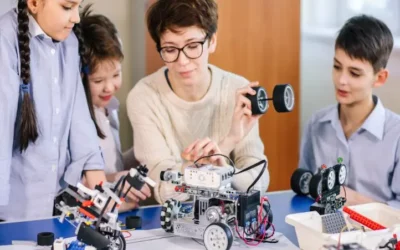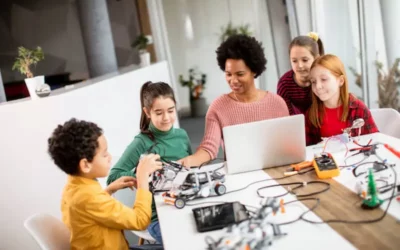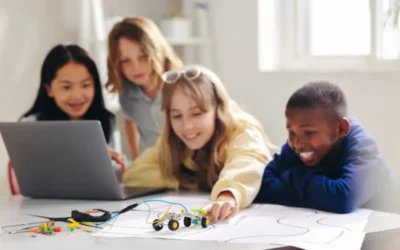In a world that’s evolving at an astonishing pace, equipping our children with the skills they need to thrive becomes paramount. As technology seamlessly integrates into every aspect of our lives, there’s one field that stands out as a captivating blend of innovation and creativity: robotics programming. It’s a realm where young minds can explore the wonders of science, engineering, and problem-solving, all while having a blast.
Welcome to our comprehensive guide, crafted especially for parents who are eager to introduce their children to the captivating world of robotics programming. Join us as we embark on a thrilling journey, unlocking the doors to a future filled with endless possibilities.
In this guide, we will demystify the realm of robotics programming, explaining its essence, impact, and how it can shape the path for our little ones. From critical thinking and collaboration to perseverance and creativity, these skills will undoubtedly become valuable assets in our children’s lives, irrespective of the path they choose to pursue.
With rapid advancements in technology, robotics programming is no longer a distant dream or a complex field reserved for experts. User-friendly platforms, intuitive coding languages, and a variety of educational resources have made it accessible to everyone. By enrolling in coding classes for kids, we can inspire young learners to take their first steps into this exciting world, equipping them with the skills to innovate and thrive in the future.
Together, we will explore the various tools, kits, and programs that cater specifically to the younger generation, providing them with the tools they need to bring their ideas to life.

But beyond technical knowledge, we’ll also touch upon the profound impact that robotics programming can have on our children’s personal growth. From nurturing their problem-solving skills to fostering resilience and adaptability, this journey will empower them to become confident, forward-thinking individuals ready to embrace the challenges of the future head-on.
So, whether you’re a tech-savvy parent keen on expanding your child’s horizons or someone new to the world of robotics programming, this guide will serve as your compass, guiding you through the fundamentals, inspiring projects, and valuable resources that will ignite a spark of curiosity and passion within your child.
Together, let’s embark on this captivating adventure, introducing robotics programming to our kids, and nurturing their potential as they unlock the door to a limitless future of innovation and creativity. The possibilities are endless, and the journey awaits. Let’s dive in!
Table of contents
Introduction
Engaging kids in the world of robotics goes beyond just toy robots; it is an excellent opportunity to encourage their problem-solving and critical-thinking skills. Robotics programming can be a fun and creative way to introduce children of all ages to coding and STEM skills.
The use of screen-free coding robot kits like Lego Boost or Sphero Mini allows younger kids to develop their motor skills and creativity, while older ones can explore more complex coding challenges with Arduino or Python.
With tools like Wonder Workshop Dash or Botley Coding Robot, children can learn the basics of block-based coding while having fun with animations or solving maze challenges.
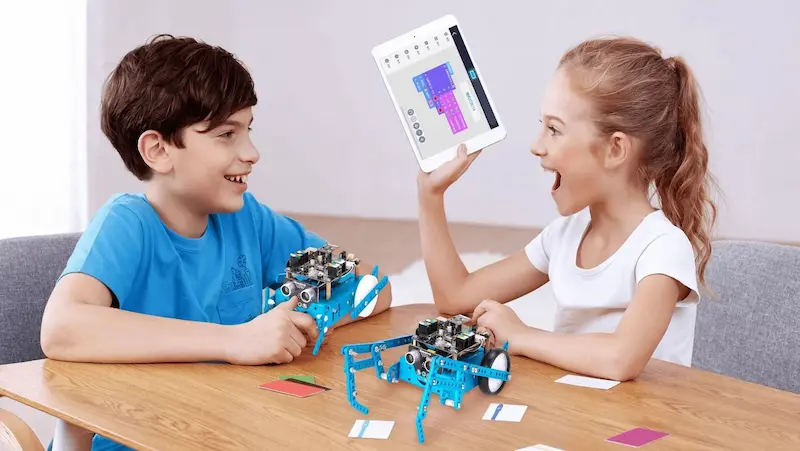
Benefits of Learning Robotics for Kids
As parents, we strive to provide our children with the best opportunities for growth and development. In this technologically driven era, where robots are no longer confined to science fiction movies, introducing robotics for kids programming, opens a gateway to a world of invaluable benefits. Kids can learn robotics with the help of robotics classes for kids. Let’s explore some of the remarkable advantages that learning robotics can offer to our young learners.
Nurturing Critical Thinking and Problem-Solving Skills:
Robotics programming encourages children to think analytically and develop effective problem-solving strategies. As they work on designing and building robots, they encounter various challenges that require logical reasoning and innovative solutions. By engaging in hands-on activities, kids learn to break down complex problems into smaller, manageable tasks, fostering their critical thinking skills and nurturing a proactive approach to finding solutions.
Cultivating Creativity and Imagination:
Robotics programming provides a canvas for young minds to unleash their creativity and imagination. Whether it’s designing the appearance of a robot, developing its functionalities, or creating interactive movements, children are encouraged to think outside the box and explore endless possibilities. This process sparks innovation and nurtures their ability to approach tasks with a fresh perspective, cultivating a sense of curiosity and wonder that can extend far beyond the realm of robotics.
Fostering Collaboration and Communication:
Robotics programming often involves teamwork, teaching kids responsibility by requiring them to collaborate with their peers, share ideas, and work towards a common goal. Through group projects and challenges, kids learn the value of effective communication, active listening, and compromise. They develop interpersonal skills, understand the importance of delegating tasks, and experience the satisfaction of achieving collective success. These collaborative experiences lay a strong foundation for future endeavors, where teamwork is an essential component.
Building Resilience and Perseverance:
Robotics programming is not always smooth sailing, and children inevitably face setbacks and obstacles along the way. However, these challenges become opportunities for growth. By encountering and overcoming difficulties, kids learn resilience and perseverance. They understand that failure is not a roadblock but a stepping stone to success. With each setback, they develop a resilience that prepares them to face adversity with determination, adaptability, and a never-give-up attitude.
Enhancing Technological Literacy and Future-Ready Skills:
In an era where technology is intertwined with every aspect of our lives, equipping our children with technological literacy becomes paramount. Learning robotics programming introduces them to coding, electronics, and mechanical engineering, providing a solid foundation in STEM (Science, Technology, Engineering, and Mathematics). These skills are highly sought after in today’s job market and will be even more critical in the future, opening doors to a wide range of career opportunities.
Inspiring a Passion for Learning:
Robotics programming offers an exciting and engaging way for children to learn and explore new concepts. The hands-on nature of building and programming robots sparks curiosity and enthusiasm, making learning an enjoyable experience. By igniting a passion for robotics, children develop a love for continuous learning and self-improvement. They become more receptive to acquiring new skills and knowledge in various domains, fostering a lifelong thirst for knowledge.
By introducing robotics for kids 5 year old, we empower them with a set of skills that extend far beyond the realm of robotics itself from an early age. We equip them with the tools to tackle future challenges, nurture their creativity, and inspire innovation. The benefits of learning robotics are truly transformative, paving the way for their success in an ever-evolving world. So, let’s embrace this exciting journey and watch our children flourish as they embark on an adventure that will shape their future in the most remarkable ways.
Understanding Robotics Programming for Kids
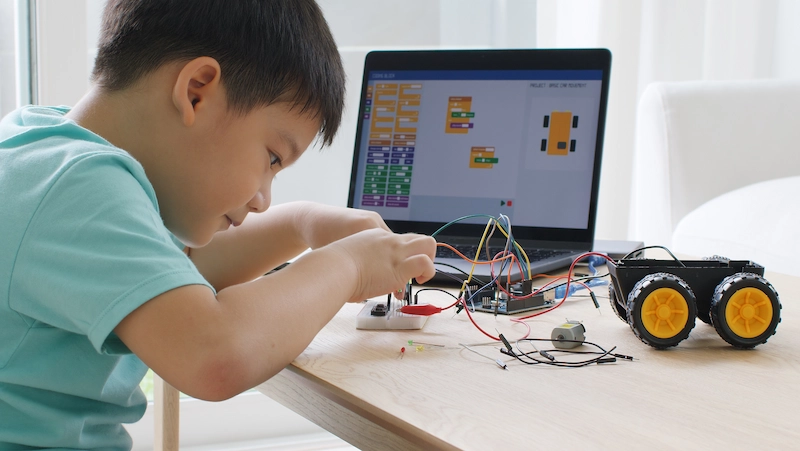
If you’re looking to introduce your child to STEM skills in an engaging way, you might have considered robotics programming for kids. Encouraging creativity, developing problem-solving skills, and promoting critical thinking abilities make robotics programming a great option for kids of all ages.
From screen-free coding to block-based coding, there are many ways to introduce young coders to the world of robotics. With beginner-friendly options like RoboCHAMPS platform by BrightCHAMPS, Lego Boost or Sphero Mini, younger kids can learn coding skills with robots that teach them through play.
For older kids, Arduino or the Thames & Kosmos Kids First Cosmos Kit allows them to get more hands-on with robot design and functionalities.
Tips for Parents to Teach Robotics Programming to Kids
Embrace Hands-On Learning:
One of the most effective ways to introduce robotics programming to kids is through hands-on activities. Encourage your child to engage with robotics kits and platforms that offer a tangible and interactive approach. These kits often come with step-by-step instructions, enabling children to build and program their own robots. By actively participating in the creation process, kids can develop a deeper understanding of programming concepts while having fun.
Start with Simple Concepts:
When beginning the journey of teaching robotics programming, it’s crucial to start with simple concepts. Introduce basic coding principles and gradually build upon them as your child gains confidence and proficiency. Begin with block-based programming languages like Scratch or Blockly, which offer a visual and intuitive interface that’s easy for kids to grasp. As they progress, you can transition to text-based languages such as Python, allowing them to explore more advanced programming techniques.
Encourage Problem-Solving:
Robotics programming provides an excellent opportunity for children to enhance their critical thinking skills for kids, as well as their problem-solving skills. Encourage your child to approach challenges with a positive and inquisitive mindset. Teach them to break down complex problems into smaller, manageable tasks, fostering logical thinking and analytical abilities. Support their exploration by asking open-ended questions, guiding them towards finding creative solutions and thinking outside the box.
Foster Collaboration:
Collaboration is a vital skill in robotics programming and mirrors the real-world dynamics of teamwork in scientific and technological fields. Encourage your child to engage in group projects or join robotics clubs or coding communities where they can collaborate with peers who share the same interests. This not only enhances their programming abilities but also nurtures their communication, cooperation, and leadership skills.
Showcase Real-World Applications:
To ignite your child’s enthusiasm for robotics programming, showcase real-world applications and success stories. Introduce them to robotics competitions, robotics in industries like healthcare and space exploration, and the exciting possibilities that lie ahead. By highlighting how robotics impacts various fields, you can inspire your child to dream big and envision their role in shaping the future through technology.
Encourage Continuous Learning:
Robotics programming is an ever-evolving field, and it’s essential to instill a love for continuous learning and teaching kids kindness in your child. Encourage them to explore online resources, tutorials, and books that delve deeper into robotics programming concepts. Encourage them to participate in coding challenges and attend workshops or camps that provide hands-on experiences beyond what you can offer at home. By fostering a growth mindset, your child will embrace new challenges and adapt to emerging technologies with confidence.
Celebrate Achievements:
Recognize and celebrate your child’s accomplishments in robotics programming. Whether it’s successfully completing a challenging project, debugging a complex code, or showcasing their creation to friends and family, acknowledging their efforts will fuel their motivation and boost their self-esteem. Encouragement and positive reinforcement will foster a lifelong passion for robotics programming and empower them to pursue their interests fearlessly.
By following these tips, you can embark on an exciting journey of teaching robotics programming to your child. Together, you’ll unlock their potential, ignite their creativity, and equip them with valuable skills for the future.
Advantages of Learning Robotics Programming for Kids
Encouraging creative thinking in children while introducing them to STEM subjects is a great way to prepare them for future careers in technology and engineering.
Robotics programming classes are an excellent option for this purpose as it helps young coders develop critical problem-solving skills and gain hands-on experience with various coding languages.
From cute robots like Artie or Botley that offer block-based coding functionalities to more complex kits like Lego Boost or Wonder Workshop Dash that require Javascript or Python programming skills; there are many options available for children of all ages.
Not only is it a fun way to learn complex concepts but it also enhances their motor skills and teamwork abilities.
Future of Robotics Programming and STEM Education
Robotics is an exciting field that offers kids of all ages a great way to learn problem-solving skills while developing their STEM skills. Children can get firsthand experience with coding and programming languages using screen-free coding robots like the Sphero Mini or Lego Boost.
A variety of robot kits like the Wonder Workshop Dash or Botley Coding Robot are available that cater to younger kids who will enjoy DIY projects like building mazes and animating other bots. These kits are also user-friendly and offer functionalities for coders who want more control over their bots.
Robotics programming courses encourage creative thinking and help develop motor skills through remote-controlled toys like the Sphero Bolt or Lego Mindstorms. With online courses available for older kids on platforms like Arduino or Python, learning robotics programming is a fun way to get a head-start on critical thinking skills. Exploring computer programs for kids can introduce them to these courses and provide hands-on experience in robotics programming and critical thinking.
Conclusion
In conclusion, introducing robotics programming using robotics courses for kids can help them develop various skills like critical thinking, problem-solving, motor skills, and creativity. It can also open doors for future career opportunities in the field of STEM.
As parents, it’s essential to provide a nurturing environment that encourages learning and offers guidance on the basics of robotics programming. From coding robots like Sphero Mini or Botley Coding Robot Activity Set to building and designing robots with Lego Boost or Mindstorms, there are many fun ways children of all ages can learn robotics programming skills.
Computer programming languages such as JavaScript or Python combined with sensor technology allow children to build animations, mazes and solve problems both on-screen and off-screen.
The future of robotics programming and STEM education is bright, and with early exposure and a little bit of guidance, your child can be at the forefront of this exciting field. Check out our FAQ section to learn more about robotics programming for kids.
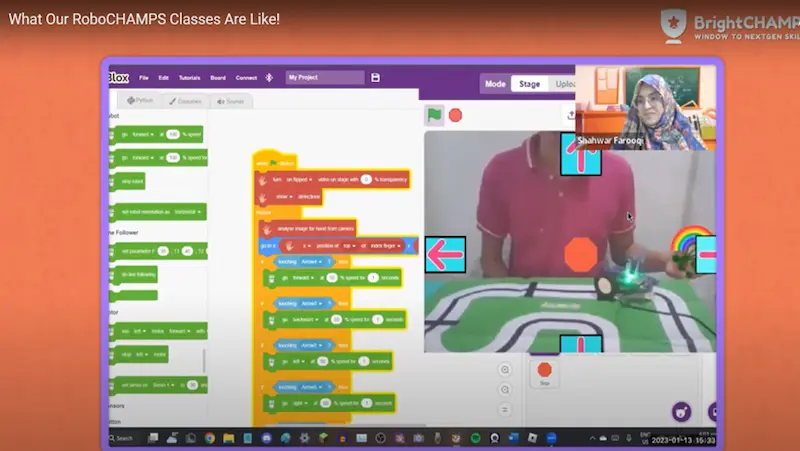
RoboCHAMPS by BrightCHAMPS is a platform that provides students with the world’s first and only all-encompassing technology curriculum – covering coding foundations, AI/ML, design thinking, and Robotics.
While learning, their student and teacher community from 25+ countries also provides an opportunity for Global collaboration. Lastly, their curriculum has been meticulously designed by their Global Curriculum Advisory Board comprising industry experts with a mission of holistic development of our students. With this passion for excellence, our team will always strive for your child’s best development. Book a Trial Class for Your Child Today!
Frequently Asked Questions
Ans 1. Robotics programming for kids is a fun and educational method of introducing coding and engineering. It involves programming robots to perform tasks or movements using block-based or text-based languages like Python. This can enhance problem-solving, creativity, and critical thinking skills. Numerous robotics programming kits are available that cater to different ages and skill levels.
Ans 2. Robotics programming for kids boosts critical thinking, problem-solving, and creativity skills. It provides knowledge on technology and its functions, preparing them for potential STEM careers in the future. Children can also learn to think outside the box while creating their own robots.
Ans 3. Robotics programming for kids often involves using beginner-friendly visual programming languages like Scratch, as well as widely used high-level programming languages like Python. Java is also a popular option for object-oriented robotics and automation programming.
Ans 4. Absolutely! There are many online resources available for kids to learn robotics programming, including interactive courses and tutorials designed specifically for children. Online communities and forums can also provide support and opportunities for learning. However, it’s essential for parents to choose reputable and safe resources for their kids.
Ans 5. Encourage your child’s interest in robotics and coding with kid-friendly platforms like Lego Mindstorms, VEX Robotics, and Dash and Dot. Each platform offers unique features for an interactive learning experience. Help your child find the best fit based on their skill level and interests by experimenting with different options. Click on the link to know more about robotics classes for kids near me.
Ans 6. Children can create and program humanoid robots, drones, and mobile robots using robotics kits that provide step-by-step instructions and pre-programmed code. Examples of popular kits are LEGO Mindstorms, Ozobot Bit, and Makeblock mBot. As they gain experience, they can write their own code and enhance their robots with sensors or other components.
Ans 7. Robotics programming teaches children essential skills such as problem-solving, critical thinking, and logical reasoning. Additionally, it fosters creativity and innovation as kids design and constructs robotic projects. Moreover, robotics programming promotes teamwork and collaboration skills by encouraging group-based activities.
Ans 8. Children can start learning the basics of robotics at a young age, with simple concepts introduced to 4-year-olds. More complex concepts can be learned by children aged 7-10 through age-appropriate robotic kits, while older children can explore coding and programming languages in robotics. The starting age should depend on the child’s interests and aptitude.
Ans 9. The duration for kids to learn robotics programming depends on their age, experience, and interest. Some grasp basic concepts in weeks, while others take months. Consistent practice and hands-on projects can speed up the learning process. Robotics programming is a fun, skill-building experience that offers valuable career opportunities.
Ans 10. While having basic programming knowledge and logical thinking skills can be advantageous, anyone, regardless of age or experience level, can learn robotics programming. Online resources, such as tutorials and forums, and interactive robotics kits with instructional manuals can make the learning process engaging and enjoyable.


 We are an army of educators and passionate learners from BrightChamps family, committed to providing free learning resources to kids, parents & students.
We are an army of educators and passionate learners from BrightChamps family, committed to providing free learning resources to kids, parents & students.








